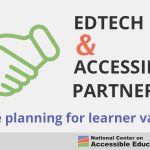Priorities
Accessibility

SETDA recommends that states and districts optimize teaching and learning for every student by developing policies and best practices that ensure the provision of accessible digital instructional materials. The National Center on Accessible Educational Materials (AEM Center), a SETDA partner, offers technical assistance to state and local policymakers and other stakeholders.
- Navigating the Digital Shift 2018: Broadening Student Learning Opportunities
- Navigating the Shift II Overview Document
- Digital Instructional Materials Acquisition Policies for States (DMAPS)
- The Accessibility of Learning Content for All Students, Including Students with Disabilities, Must Be Addressed in the Shift to Digital Instructional Materials
With the shift from print to digital, education leaders must proactively consider the accessibility of digital resources for all students. Digital instructional materials can present significant learning barriers for students with disabilities. When they are accessible, digital materials are designed in a way that makes them usable across the widest range of student variability regardless of media type (graphic, audio video, simulation, etc.). Policy guidance and accessibility standards are in place to support the provision of accessible digital materials for all students. Universal Design for Learning (UDL), a framework referenced in ESSA and the National Educational Technology Plan, guides the use of accessible curriculum materials for reducing barriers and maximizing learning opportunities. Nationally accepted accessibility standards are available for guiding both the development and the procurement of accessible digital materials, including the Section 508 Standards and the W3C Web Content Accessibility Guidelines (WCAG).
If accessibility features are not designed within the digital materials, it will be difficult or impossible for some students to use them due to a range of physical, sensory and/or cognitive disabilities. If materials cannot be used by these students, their ability to learn and achieve will be adversely effected. An equitable learning environment does not mean students have equal digital tools. Rather, all students should use the tools that support their learning needs, i.e., switches, augmentative communication devices, and scheduling tools. Accessibility refers to having the tools available for use and the ability to use the tools. As required by federal statutes, including IDEA and civil rights legislation, state and local education agencies must ensure that students who need accessible materials and technologies receive them in a timely manner. Timely manner is generally defined as “at the same time other students receive their materials.
SETDA recommends that states and districts meet federal requirements by including accessibility in policies regarding the development, distribution/sharing and use of digital materials and technologies to improve the learning experiences of ALL students. Policies should include:
- Establishing a clear vision for the use of accessible digital learning materials and communicating that vision to relevant stakeholders, including content creators and content users.
- Ensuring digital materials procured from commercial and free sources meet accessibility standards, such as WCAG 2.0 (minimum level AA compliance) and Section 508 of the Rehabilitation Act.
- Supporting the development and use of accessible open educational resources to maximize flexibility
- Requiring that customization options be available for educators to personalize learning and meet individual student needs.
- Providing educators with professional learning opportunities on the proper use of accessible educational materials.
- Ensuring that educators have access to online repositories of quality accessible digital content.
- Investing in research and evaluation to assess the impact of accessible digital learning materials on student achievement and engagement and to share best practices
- Investing in research and evaluation to assess the impact of accessible digital learning materials on student achievement and engagement and to share best practices.
Key Definitions
- Accessible educational materials (AEM) are print- and technology-based educational materials, including printed and electronic textbooks and related core materials that are designed or enhanced in a way that makes them usable across the widest range of learner variability, regardless of format (e.g. print, digital, graphic, audio, video).
- IDEA (Individuals with Disabilities Education Act) specifically focuses on the provision of accessible print instructional materials in the specialized formats of braille, large print, audio, and digital text to students who need them in a timely manner.
- WCAG (Web Content Accessibility Guidelines) provides a wide range of recommendations for making web content more accessible for people with disabilities and more usable in general.
